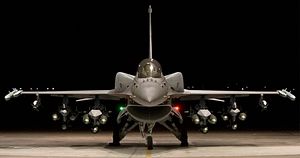The Republic of Korea Air Force (ROKAF) has upgraded the first batch of its fleet of KF-16C/D Block 50/52 fighter jets, a variant of the General Dynamics F-16 Fighting Falcon, arming the aircraft with bombs capable of destroying key underground targets in North Korea, according to local media reports.
Defense Industry Daily reports that 35 KF-16 fighter jets have been upgraded so far and are now capable of firing the AIM-120 mid-range air-to-air missile and drop the GBU-31JDAM (Joint Direct Attack Munition) air-to-ground guided bomb. The $250 million upgrade of the 35 fighter jets is part of the ROKAF’s so-called F-16 Peace Bridge Upgrade (PBU) program initiated in November 2009.
The GBU-31 JDAM is a guidance tail kit that converts unguided bombs—for example, the 2,000-pound BLU-109/MK 84, the 1,000-pound BLU-110/MK 83 or the 500-pound BLU-111/MK 8 warheads—into guided air-to-surface weapons. “The upgraded F-16 PBUs will have the same capability of the KF-16 jets and will operate as the main combat planes charged with defending South Korea’s air,” according to an unnamed ROKAF official.
The ROKAF currently operates 170 KF-16C/D Block 50/52 fighter aircraft, 134 of which will be undergoing extensive modernization and upgrades. In November, Lockheed Martin was awarded a $1.2 billion contract to upgrade the 134 aircraft based on the advanced F-16V configuration—the latest and technologically most advanced version of the fourth generation fighter jet.
The upgrades, next to advanced weapons, will include “an Active Electronically Scanned Array (AESA) radar, a modern commercial off-the-shelf (COTS)-based avionics subsystem, a large-format, high-resolution center pedestal display and a high-volume and high-speed data bus,” according to Lockheed Martin press release. Work on all 134 aircraft is slated to be completed by November 2025.
“As Original Equipment Manufacturer (OEM) and design authority of the F-16, Lockheed Martin is uniquely qualified to design, engineer, develop, integrate and sustain a complete F-16 weapons system solution tailored to customer requirements,” Lockheed Martin notes. (The contract had first been awarded to BAE Systems in 2012. However, it was reportedly cancelled by the South Korean government in 2014 after the costs had increased by $700 million.)
The Lockheed Martin contract was awarded following a July 2015 decision of the Pentagon’s Defense Security Cooperation Agency (DSCA) to approve a possible foreign military sale for the ROKAF’s F-16 Peace Bridge Upgrade (PBU) program, which included associated equipment, parts and logistical support for an estimated cost of $2.5 billion. According to a DSCA press release, the ROKAF upgrade program aims to ensure “interoperability and continued relations between the ROK and the U.S. Government for the foreseeable future.”
































